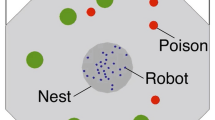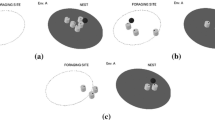Abstract
Swarm robotics is a field in which multiple robots coordinate their collective behavior autonomously to accomplish a given task without any form of centralized control. In swarm robotics, task allocation refers to the behavior resulting in robots being dynamically distributed over different sub-tasks, which is often required for solving complex tasks. It has been well recognized that evolutionary robotics is a promising approach to the development of collective behaviors for robotic swarms. However, the artificial evolution often suffers from two issues—the bootstrapping problem and deception—especially when the underlying task is profoundly complex. In this study, we propose a two-step scheme consisting of task partitioning and autonomous task allocation to overcome these difficulties. We conduct computer simulation experiments where robotic swarms have to accomplish a complex collective foraging problem, and the results show that the proposed approach leads to perform more effectively than a conventional evolutionary robotics approach.







Similar content being viewed by others
Notes
All experiments are conducted with an open-source 2D physics engine—Box2D, http://box2d.org.
References
Brambilla M, Ferrante E, Birattari M, Dorigo M (2013) Swarm robotics: a review from the swarm engineering perspective. Swarm Intell 7(1):1–41
Şahin E (2004) Swarm robotics: from sources of inspiration to domains of application. International workshop on swarm robotics. Springer, Berlin, Heidelberg, pp 10–20
Trianni V, Nolfi S, Dorigo M (2008) Evolution, self-organization and swarm robotics. In: Blum C, Merkle D (eds) Swarm intelligence. Springer, Berlin, pp 1–41
Liu W, Winfield A (2010) Modelling and optimisation of adaptive foraging in swarm robotic systems. Int J Robot Res 29(14):1743–1760
Nolfi S, Floreano D (2000) Evolutionary robotics: the biology, intelligence, and technology of self-organizing machines. MIT Press, Cambridge
Francesca G, Birattari M (2016) Automatic design of robot swarms: achievements and challenges. Front Robot AI 3:29
Floreano D, Dürr P, Mattiussi C (2008) Neuroevolution: from architectures to learning. Evol Intell 1(1):47–62
Soysal O, Şahin E (2005) Probabilistic aggregation strategies in swarm robotic systems. In: Proceedings of the 2005 IEEE swarm intelligence symposium, pp 325–332
Nouyan S, Campo A, Dorigo M (2008) Path formation in a robot swarm. Swarm Intell 2(1):1–23
Groß R, Dorigo M (2009) Towards group transport by swarms of robots. Int J Bio-Inspired Comput 1(1–2):1–13
Pini G, Brutschy A, Frison M, Roli A, Dorigo M, Birattari M (2011) Task partitioning in swarms of robots: an adaptive method for strategy selection. Swarm Intell 5(3–4):283–304
Gomez F, Miikkulainen R (1997) Incremental evolution of complex general behavior. Adapt Behav 5(3–4):317–342
Whitley LD (1991) Fundamental principles of deception in genetic search. Found Genet Algorithms 1:221–241
Agassounon W, Martinoli A, Goodman R (2001) A scalable, distributed algorithm for allocating workers in embedded systems. IEEE Int Conf Syst Man Cybern 5:3367–3373
Parker LE (1998) ALLIANCE: an architecture for fault tolerant multirobot cooperation. IEEE Trans Robot Autom 14(2):220–240
Krieger MJ, Billeter JB (2000) The call of duty: self-organised task allocation in a population of up to twelve mobile robots. Robot Auton Syst 30(1–2):65–84
Agassounon W, Martinoli A (2002) Efficiency and robustness of threshold-based distributed allocation algorithms in multi-agent systems. In: Proceedings of the first international joint conference on autonomous agents and multiagent systems: part 3. ACM, Bologna, pp 1090–1097
Brutschy A, Pini G, Pinciroli C, Birattari M, Dorigo M (2014) Self-organized task allocation to sequentially interdependent tasks in swarm robotics. Auton Agents Multi-agent Syst 28(1):101–125
Silva F, Duarte M, Correia L, Oliveriram SM, Christensen AL (2016) Open issues in evolutionary robotics. Evol Comput 24(2):205–236
Lehman J, Stanley KO (2011) Abandoning objectives: evolution through the search for novelty alone. Evol Comput 19(2):189–223
Lehman J, Stanley KO, Miikkulainen R (2013) Effective diversity maintenance in deceptive domains. In: Proceedings of the 15th annual conference on genetic and evolutionary computation. ACM, pp 215–222
Lehman J, Miikkulainen R (2014) Overcoming deception in evolution of cognitive behaviors. In: Proceedings of the 2014 annual conference on genetic and evolutionary computation (GECCO '14). ACM, pp 185–192
Christensen AL, Dorigo M (2006) Incremental evolution of robot controllers for a highly integrated task. In: International conference on simulation of adaptive behavior, pp 473–484
Togelius J (2004) Evolution of a subsumption architecture neurocontroller. J Intell Fuzzy Syst 15(1):15–20
Duarte M, Oliveira SM, Christensen AL (2015) Evolution of hybrid robotic controllers for complex tasks. J Intell Robot Syst 78(3–4):463–484
Celis S, Hornby G.S, Bongard J (2013) Avoiding local optima with user demonstrations and low-level control. In: Proceedings of the IEEE congress on evolutionary computation, pp 3403–3410
Von HE (1990) Task partitioning: an innovation process variable. Res Policy 19(5):407–418
Pini G, Brutschy A, Pinciroli C, Dorigo M, Birattari M (2013) Autonomous task partitioning in robot foraging: an approach based on cost estimation. Adapt Behav 21(2):118–136
Beyer HG, Schwefel HP (2002) Evolution strategies: a comprehensive introduction. Nat Comput 1(1):3–52
Author information
Authors and Affiliations
Corresponding author
About this article
Cite this article
Wei, Y., Hiraga, M., Ohkura, K. et al. Autonomous task allocation by artificial evolution for robotic swarms in complex tasks. Artif Life Robotics 24, 127–134 (2019). https://doi.org/10.1007/s10015-018-0466-6
Received:
Accepted:
Published:
Issue Date:
DOI: https://doi.org/10.1007/s10015-018-0466-6




